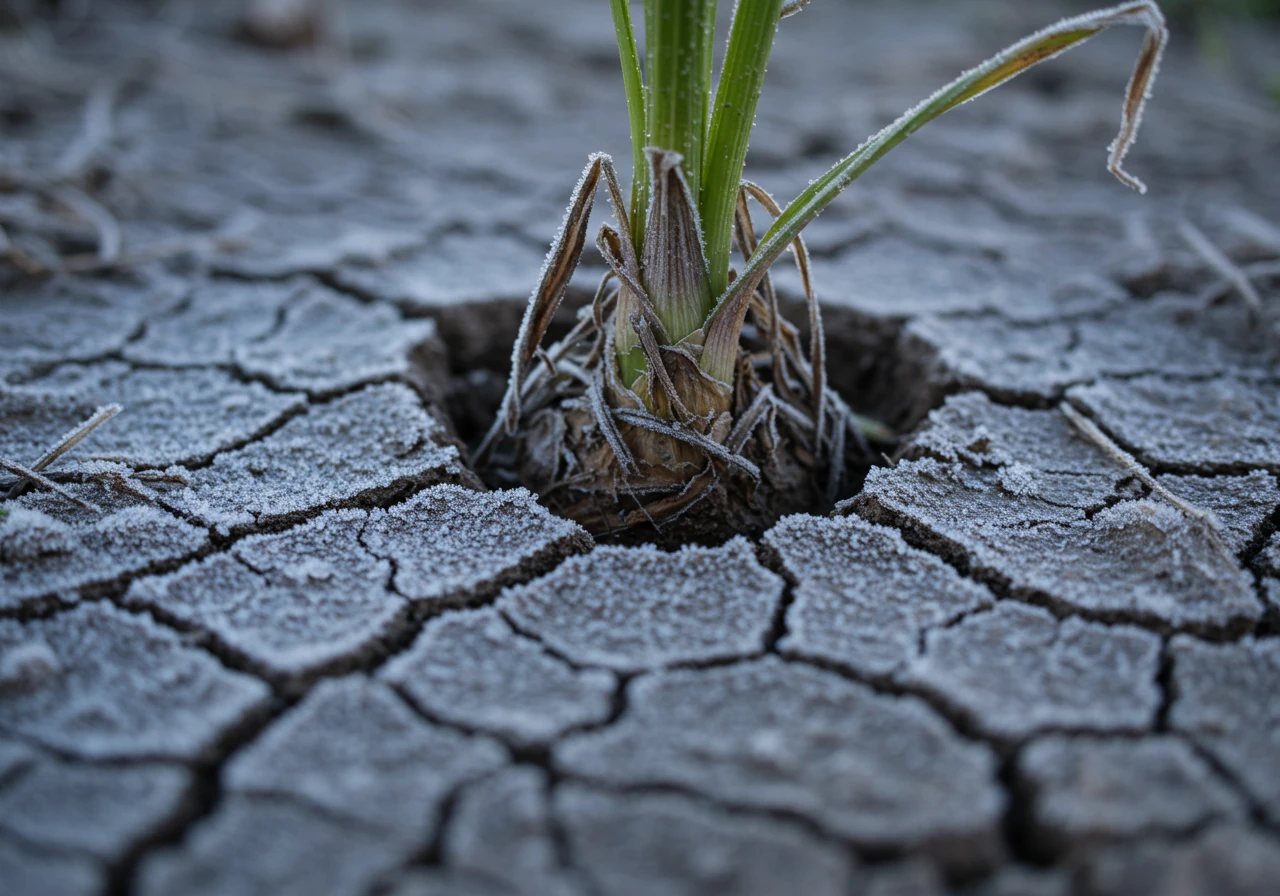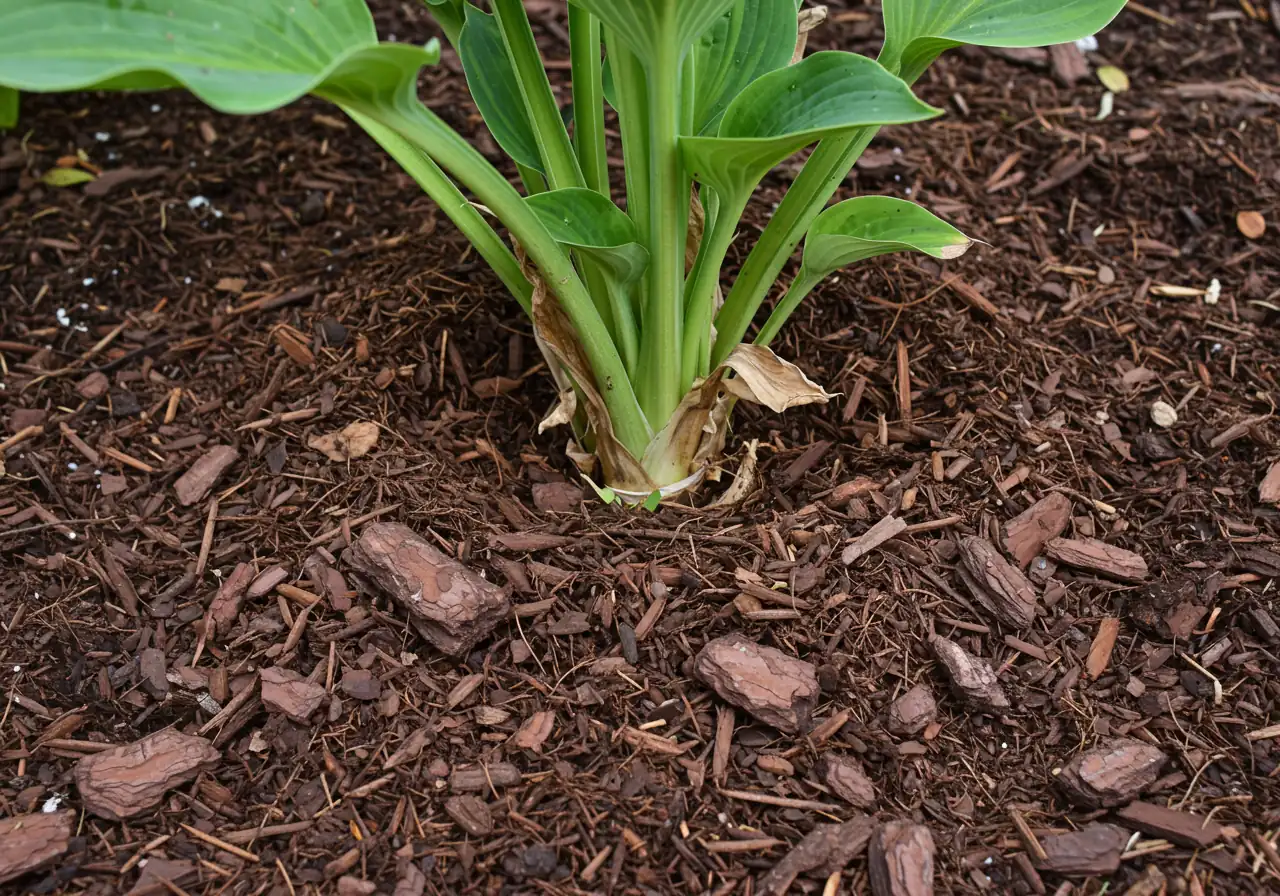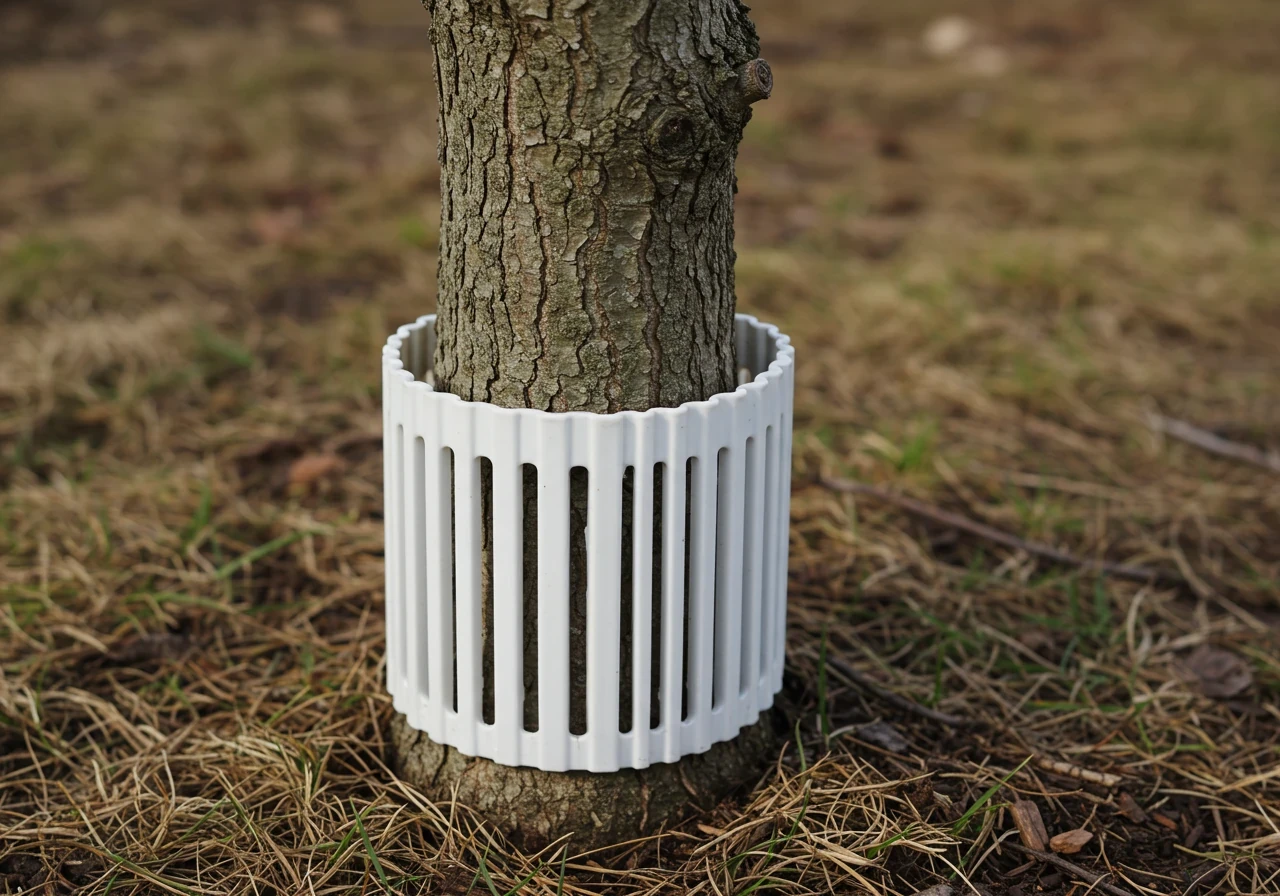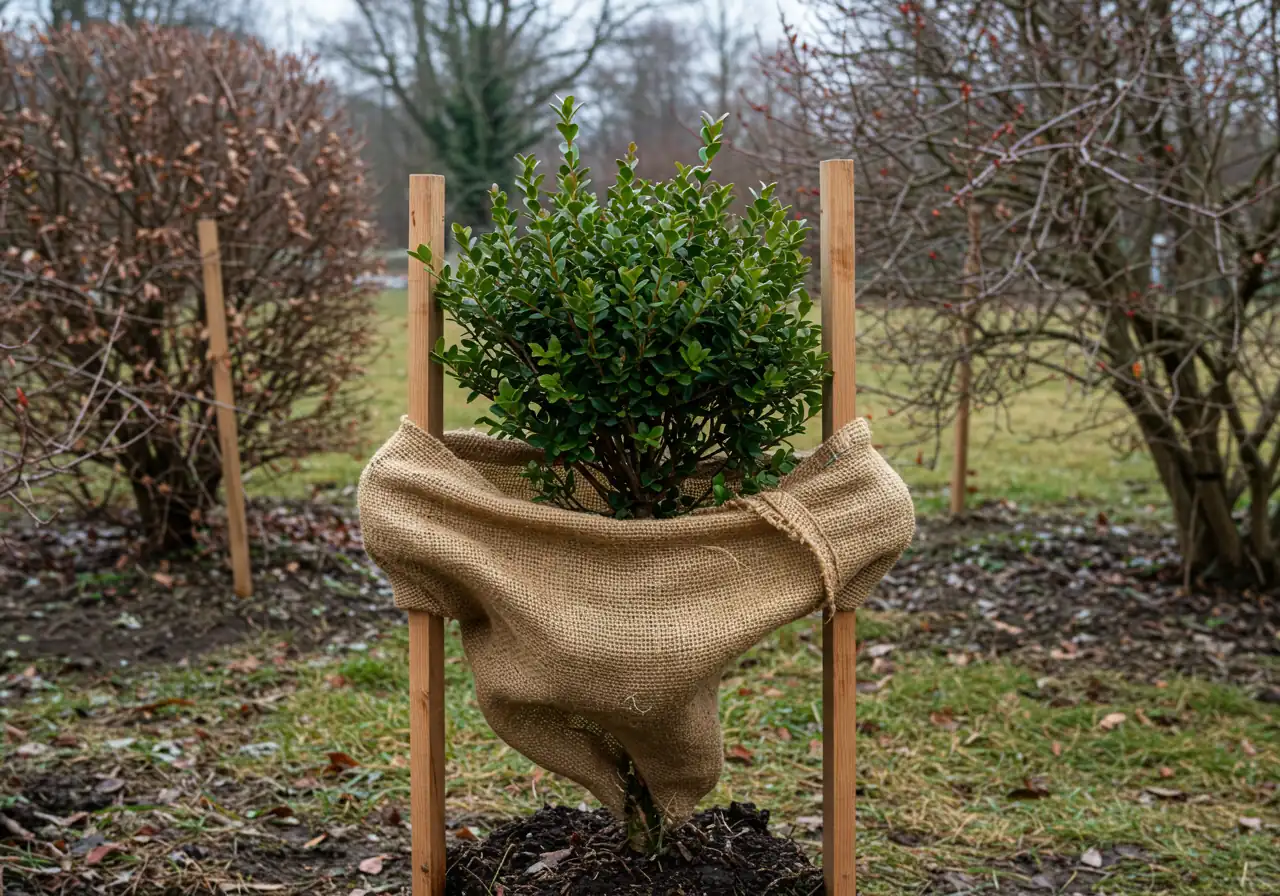Russell Microclimate Winter Prep: Protect Your Plants
Winter is coming! Is your Russell garden ready? Don’t let the Ottawa freeze catch your plants unprepared. Request a free estimate today for professional fall cleanup and winterizing services!
Winter Prep Quick Guide:
- Understand your Russell microclimate’s impact.
- Protect plants from deep freezes, frost heave, snow/ice, and windburn.
- Improve clay soil drainage with compost before winter.
- Apply 2-3 inches of winter mulch after first frost but before ground freeze.
- Wrap vulnerable plants (evergreens, tender roses) with burlap.
- Protect young tree trunks from rodents with guards.
- Water trees deeply before the ground freezes solid.
Introduction: Brrr-ace Yourselves! Winter is Coming to Russell (and Your Garden!)
Hello Russell neighbours! Feel that crispness creeping into the morning air? That’s the unmistakable sign that winter is plotting its return to the Ottawa region. And let’s be honest, Ottawa winters aren’t exactly known for being gentle! While folks in nearby spots like Embrun or Metcalfe are also preparing, Russell, with its unique mix of village charm and surrounding open spaces, can sometimes feel winter’s bite just a little differently. Don’t let Jack Frost catch your garden unprepared!
This guide is your go-to resource for getting your specific Russell landscape ready to handle the snow, ice, and deep freeze ahead. We know you’ve invested time and love into your gardens, whether it’s nurturing vibrant perennials or maintaining a neat lawn with regular lawn care. Now it’s time for some essential winter protection. We’ll walk through practical, actionable steps – from safeguarding tender plants and preparing your soil before the ground freezes solid using tips from our soil preparation guide, to simple tool care that saves headaches later. Think of this as giving your cherished outdoor space a cozy winter coat. Let’s get started and ensure your garden not only survives the cold months but is ready to burst back to life beautifully next spring!
Decoding the Chill: Understanding Russell’s Microclimate & Ottawa’s Winter Woes

Okay, let’s talk about Russell’s special brand of winter and why your garden might experience things a little differently than downtown Ottawa, or even nearby spots like Greely or Metcalfe. It often comes down to something called a microclimate.
Think of a microclimate as your yard’s own tiny weather zone. Factors like whether your garden is sheltered by buildings, close to the Castor River, has lots of mature trees providing cover, or is wide open to those sweeping winds can make it slightly warmer or colder than the official forecast. Even the colour of your house or driveway can play a role by absorbing or reflecting heat! Understanding these little variations is key to smart gardening. Want to dig deeper into this? Check out these insights on identifying to figure out the unique zones in your own yard.
Now, regardless of your specific microclimate, all of us in the broader Ottawa region face similar winter challenges. Jack Frost has a few nasty party tricks up his sleeve that our landscapes need to endure:
- Deep Freezes: Temperatures plummeting well below zero Celsius can seriously damage roots and flower buds, especially on plants that are borderline hardy for our zone.
- Freeze-Thaw Cycles: Sunny winter days melting snow, followed by freezing nights? This is brutal for plants! It causes the soil to heave (pushing plants right out of the ground sometimes) and can easily snap roots.
- Heavy Snow & Ice: It might look like a winter wonderland, but the sheer weight of heavy, wet snow or solid ice can snap branches on trees and shrubs. Keeping plants healthy year-round, perhaps by following good practices like those mentioned in these summer pruning secrets for garden vitality, helps them withstand this stress better.
- Drying Winds: Winter wind acts like a giant hairdryer, sucking precious moisture out of evergreen needles (causing that brown, burnt look) and exposed stems. This is often called windburn.
The type of soil in your garden also plays a huge role in winter survival. Much of the area around Russell, Greely, and Metcalfe features heavy clay soil. While clay is great at holding nutrients, it also holds a lot of water. In winter, this means it can freeze solid like concrete and is especially prone to that damaging frost heave we mentioned. Improving drainage and soil structure with organic matter before winter really helps plants cope. If you’re planning on adding trees or shrubs, knowing how to handle this soil is vital; take a look at our specific for practical advice. And while you’re preparing your plants, don’t forget about your outdoor furniture! Properly storing items extends their life, but maybe you can find year-round inspiration with these , focusing on durable materials.
Understanding these local conditions – your specific microclimate, Ottawa’s general winter hazards, and your soil type – helps you make smarter choices for winter protection and ensures your landscape investment thrives. If sorting through all the winter prep tasks feels a bit much, remember that professional help is always an option through our various landscaping and garden care services. Consider checking our excellent reviews on our Google My Business page.
Tucking In Your Garden Beds: Soil Prep & Insulation Station

Alright garden enthusiasts, the main growing show might be over, but don’t hang up your trowels just yet! Think of fall cleanup and prep as lovingly tucking your garden beds in for their long winter nap. This isn’t just about tidiness; it’s crucial for setting up a spectacular comeback tour next spring, especially with the kind of winters we get here in Ottawa.
First things first: a good cleanup. Remove spent annuals (they won’t be back, bless their cotton socks) and cut back any diseased perennial foliage to prevent problems from overwintering. Leaving healthy perennial stems can add winter interest and provide habitat, but diseased stuff has got to go! If tidying up feels like too big a job, remember expert help is available. You can check out options like the Russell garden clean-up service or even similar services tailored for areas like the Metcalfe garden clean-up service and Marionville garden clean-up service.
Once the beds are tidy, let’s talk soil. Fall is prime time for soil amending. Why now? Adding organic matter like compost or well-rotted manure in the fall gives it all winter to break down. This process gradually improves soil structure – super important for the heavy clay common in areas around Ottawa, like Manotick or Osgoode. Better structure means better drainage (less soggy roots!) and aeration, making life much nicer for your plant roots come spring. Simply spread a couple of inches over the bed and gently work it into the top layer, or just let the worms do the heavy lifting over winter. Find quality materials through our material selection guide.
Now for the cozy blanket: winter mulch! This is your garden’s insulation station. A good layer of mulch does several amazing things:
- Regulates Temperature: Like a duvet, it buffers roots against those harsh freeze-thaw cycles that cause frost heave.
- Conserves Moisture: Reduces water evaporation from the soil, preventing roots from drying out in winter winds.
- Suppresses Weeds: Keeps those pesky early spring weeds from getting a head start.
- Prevents Erosion: Protects your precious amended soil from washing away during heavy rains or snowmelt.
Your Simple Mulching Guide: Step-by-Step
Step 1: Clean Sweep
Ensure the garden bed is thoroughly weeded before applying any mulch. Remove fallen leaves and debris.
Step 2: Apply Evenly
Spread your chosen mulch (shredded bark, leaves, straw) to a depth of 2-3 inches (5-8 cm) over the soil surface.
Step 3: Give ‘Em Space!
This is critical: Keep mulch *away* from direct contact with plant stems, tree trunks, or shrub crowns. Leave a ‘donut hole’ gap to prevent rot and pests.
Step 4: Timing is Key
Apply mulch *after* the first light frost but *before* the ground freezes solid. This lets the soil cool down first.
Which Mulch to Choose?
- Shredded Bark/Wood Chips: Long-lasting, looks neat. Breaks down slowly, improving soil over time.
- Straw: Excellent insulator, especially for covering things like garlic or strawberry beds. Can look messy and may contain weed seeds.
- Shredded Leaves: Eco-friendly gold! Free, readily available, and decomposes beautifully, adding nutrients. Run over them with a lawnmower first to chop them up and prevent matting.
Proper mulching is a cornerstone of garden health. If you’re looking for professional results, explore options for expert mulching and edging services.
Taking these steps – cleaning up, amending the soil, and applying a protective mulch layer – gives your plants the best chance to survive Ottawa’s winter and thrive next year. It’s a bit of work now for a huge payoff later! Need help managing your garden tasks? Existing clients can easily schedule services through the convenient online customer portal, while new clients can browse all our comprehensive landscaping and garden care services online. We also offer services in surrounding areas like Ottawa property cleanup and Marionville property cleanup. Sweet dreams to your garden beds!
Sweater Weather for Shrubs & Co.: Protecting Your Vulnerable Plants
Okay, let’s talk about playing favourites in the garden – winter edition! While some of your landscape troopers are tough enough to handle an Ottawa winter au naturel, others need a bit of extra coddling. Think of it as getting out the cozy sweaters and winter jackets for your more delicate green buddies. Protecting these vulnerable plants now means less heartbreak (and fewer replacements!) come spring.


Who Needs a Winter Wardrobe?
Not every plant needs bundling up. But pay special attention to these common characters found in gardens from Nepean to Metcalfe:
- Broadleaf Evergreens: Plants like Rhododendrons, Boxwood, Euonymus, and some Hollies keep their leaves all winter. This makes them prime targets for drying winds (desiccation) and winter sun scald (damage from sun reflecting off snow).
- Tender Roses: Many hybrid tea roses and other grafted varieties need their graft union (the knobbly bit near the base) protected from deep freezes.
- Newly Planted Trees and Shrubs: Youngsters haven’t established deep roots yet, making them more susceptible to everything winter throws at them. Good initial soil preparation gives them a head start, but extra protection is wise. Perhaps consider a full garden installation next season.
- Borderline Hardy Plants: Anything rated for Zone 5b or warmer might struggle in a particularly harsh Ottawa winter (we’re mostly Zone 5a).
Your Plant Protection Toolkit & How-Tos
- Burlap Wrapping
- Anti-Desiccant Sprays
- Mulch & Rose Collars
- Rodent Protection
- Snow Protection
Burlap Bonanza (Wrapping & Screens)
This is the classic winter armour, especially effective against windburn and salt spray.
Why? Burlap blocks drying winds and shades plants from intense winter sun. It can also form a physical barrier against salt splashed from roads – essential if you live along busier routes in places like Richmond or Kars.
How to Wrap:
- Place 3-4 stakes around the shrub, slightly wider than the plant. Avoid driving stakes through the main root ball.
- Wrap burlap around the stakes, overlapping edges. Don’t wrap directly against foliage; allow an air gap for insulation. Ensure stakes are sturdy, especially in windy spots like Vernon or Kenmore.
- Secure burlap with twine or zip ties. Wrap to the top or slightly above.
- Avoid wrapping the top completely flat to prevent heavy snow/ice accumulation. Allow some air circulation.
Alternative: Create a simple burlap screen on the windward (usually north/west) or road-facing side.
Anti-Desiccant Sprays (The Invisible Shield)
Why? These waxy sprays coat evergreen leaves, reducing moisture loss from wind. Think of it like lip balm for leaves! Great for Boxwood and Rhododendrons.
How? Apply on a mild, dry day (above 4°C) in late fall before the deep freeze. Follow product instructions carefully. A second application mid-winter during a thaw might be beneficial.
Mulch Moats & Rose Collars
Why? Protects root zones and tender crowns/graft unions from freeze-thaw cycles.
How? After the ground starts to freeze, mound 8-12 inches of loose soil, compost, or mulch around the base of roses, covering the graft union. Use rose collars (plastic or paper cylinders) to hold the mound neatly.
Rodent Warding (Critter Control)
Why? Rabbits and mice love nibbling tender bark in winter. This can girdle and kill young trees and shrubs. Keeping the area tidy reduces hiding spots; thorough fall cleanups, like those offered by a Metcalfe property cleanup service or similar services in areas like Marionville property cleanup service or even general property clean up, can make a difference.
How? Install plastic tree guards around young tree bases. For shrubs, create a cylinder of hardware cloth (wire mesh) around the base, tall enough to extend above the snow line and buried slightly. Ensure mesh doesn’t touch branches.
Snow Savvy
Why? Heavy, wet snow can snap branches, especially on upright evergreens like cedars or junipers.
How? Gently brush heavy snow off branches with a broom (upward motion!). For habitually splaying shrubs, loosely tie branches together with soft twine or build a simple wooden A-frame structure over them before snow flies.
Taking these steps might seem like a bit of work, but it’s a worthwhile investment in your landscape’s health. Remember, a little prep goes a long way! And if tackling burlap wrapping or extensive cleanup feels daunting, professional help is available. Don’t hesitate to reach out for assistance – and if you’ve used services like our Metcalf garden clean-up service or Ottawa garden clean up service before, we always appreciate hearing about your experience via our estimate feedback form! Give your plants their winter best, and they’ll thank you with beautiful growth next season.
Typical Winter Challenges in Ottawa Area
*Estimated prevalence of common winter plant stressors in the Ottawa region.
Tree Time: Winterizing Your Woody Wonders & Evergreens
Alright, let’s talk trees! They might seem like the stoic, silent giants of your landscape, toughing out whatever Ottawa throws at them. And while many mature, native trees handle winter like seasoned pros, even they (and especially younger or evergreen trees) appreciate a little winter TLC. Don’t leave your woody wonders out in the cold without a thought – preventative care now avoids major headaches later!
Thirsty Work Before the Freeze:
Believe it or not, trees can get thirsty even when it’s cold, especially evergreens that lose moisture through their needles all winter. Before the ground freezes solid (usually mid-to-late fall), give your trees, particularly young ones and evergreens, a good, deep drink. Water slowly at the drip line (the area under the outermost branches) until the soil is moist several inches down. This hydration helps prevent root damage and winter desiccation (drying out). Think of it as giving them one last big gulp before the taps freeze!
Evergreen Escapades: Burn, Breakage, and Barriers
Our evergreen friends – pines, spruce, cedars, etc. – face unique winter challenges:
- Winter Burn: Just like the broadleaf evergreens we discussed earlier, needles can get scorched by harsh winter sun and drying winds, turning them brown and crispy. While anti-desiccant sprays can help smaller evergreens, protecting larger ones involves ensuring they are well-watered before freeze-up. Sometimes, strategic planting out of the harshest wind corridors is the best long-term defense. Check out some inspiring examples of well-placed trees in our gallery of landscape transformations featuring beautiful trees or our general gallery.
- Snow Load Sadness: Heavy, wet snow clinging to branches can spell disaster, especially for multi-stemmed trees like cedars or upright junipers. Gently brush off accumulating snow with a broom using an upward sweeping motion to avoid snapping branches. Never shake the tree vigorously! For chronically splaying trees, loosely tying stems together with soft twine before winter can provide support.
- Salt Assault: If you live in areas with road salt use, like many streets in Barrhaven or Nepean, your trees near the road or driveway are vulnerable. Salt spray coats needles and buds, causing damage, while salt runoff poisons the soil, harming roots. Creating a physical barrier with burlap staked on the side facing the road can help deflect spray on smaller trees. Improving drainage away from the tree’s root zone is also key. In spring, deeply watering the area can help flush residual salt from the soil – a good time to think about reviving nearby lawn areas too, perhaps even considering professional sod installation if salt damage was severe.
Quick Inspection Check-Up:
Before the snow flies, take a walk around and look up! Check your trees for any dead, damaged, or dangling branches. Winter winds and snow load can bring these down unexpectedly. Addressing minor pruning of hazardous branches now is safer than dealing with major breaks later. Significant pruning, however, is usually best left for late winter or early spring when the tree is dormant. Unsure what needs trimming? It might be wise to get a professional opinion. If tackling complex tree care feels overwhelming, you can always book an estimate for tree care services to ensure it’s done safely and correctly. If we’ve helped with your trees or landscape before, we’d love it if you shared your thoughts via our estimate feedback form. You can also review our terms and conditions for service agreements.
A little attention now ensures your trees remain healthy, majestic assets to your property for years to come. Got more tree troubles or specific questions about your landscape? Don’t hesitate to reach out – simply contact us with your questions.
Common Vulnerable Plants & Protection Summary
| Plant Type | Primary Risk | Recommended Protection |
|---|---|---|
| Broadleaf Evergreens (Rhododendron, Boxwood) | Windburn, Sun Scald | Burlap Wrap/Screen, Anti-Desiccant Spray |
| Tender Roses (Hybrid Teas) | Graft/Crown Freeze | Mound Soil/Mulch, Rose Collar |
| Newly Planted Trees/Shrubs | Root Freeze, Frost Heave, Rodents | Deep Watering, Mulch, Tree Guard/Mesh |
| Upright Evergreens (Cedars, Junipers) | Snow Load Breakage, Salt Spray | Gentle Snow Removal, Twine Tying (optional), Burlap Screen (if near road) |
| Perennials in Clay Soil | Frost Heave | Soil Amendment (Compost), Thick Mulch Layer |
FAQs: Your Russell & Ottawa Winter Woes Solved!
You’re not alone! It’s a common head-scratcher. Aim to apply winter mulch *after* the first light frost has kissed the ground, but *before* it freezes solid – usually late October or early November here in Ottawa. Wrap tender shrubs like broadleaf evergreens around the same time, or slightly later, ensuring they are well-watered beforehand. You want the plant dormant but the ground still workable.
Absolutely! Clay soil holds lots of water, which means more frost heave during freeze-thaw cycles. This can push plants right out of the ground! Ensure good drainage by adding plenty of compost in the fall. Applying a thick layer (3-4 inches) of insulating mulch like shredded bark or leaves is extra important on clay to keep the soil temperature stable.
Great question! Using shredded leaves from your own yard (or a neighbour’s!) as mulch is fantastic – it’s free, insulates well, and feeds the soil. Burlap is a natural fiber that works well for wrapping shrubs. Leaving healthy perennial seed heads and grasses standing provides winter interest and food/shelter for wildlife. Consistent, good year-round garden maintenance practices also build stronger plants less reliant on heavy protection. Check out Ottawa’s resources on sustainable gardening for more ideas.
It depends on the type! Bigleaf Hydrangeas (like ‘Endless Summer’) bloom on old wood, which can be killed by our harsh Ottawa winters. Protect these by mounding mulch or soil around the base and potentially wrapping them with burlap stuffed lightly with leaves. Panicle (‘Limelight’) and Smooth (‘Annabelle’) hydrangeas bloom on new wood, so winter protection isn’t usually needed for flowering – just basic cleanup! The Friends of the Central Experimental Farm often have great plant-specific advice.
Salt spray is brutal! The best defense is distance, but if that’s not possible, creating a physical barrier is key. Erecting a burlap screen on stakes between the road and your cedars *before* winter helps deflect the worst of the spray. Planting salt-tolerant species nearby can also help buffer more sensitive plants. While we handle various yard tasks, like our specialized Metcalf yard cleanup service or Marionville yard cleanup service, salt barrier construction is something you can often DIY effectively. Consider consulting resources like the Rideau Valley Conservation Authority for shoreline planting tips which sometimes include salt tolerance.
It’s a mix! Cut back diseased foliage to prevent problems from overwintering. Remove soggy annuals. However, leaving sturdy perennial stems (like Coneflowers, Sedum) and ornamental grasses provides winter visual interest and important habitat for beneficial insects. You can learn more about our approach and experience helping local homeowners by checking out our About Us page. When you connect with us, rest assured your information is handled carefully as outlined in our Privacy Policy. We aim for a positive outcome, just like our thank you page suggests!
Conclusion: Sleep Tight, Little Plants! (And Call Us If You Need a Hand!)
Whew! We’ve covered a lot of ground, haven’t we? From battling frost heave in clay soil to giving your cedars a fighting chance against salt spray, getting your Russell garden ready for an Ottawa winter is no small feat. But think of it this way: all that mulching, wrapping, and prepping is like tucking your precious trees, shrubs, and perennials in with a cozy blanket, ensuring they wake up refreshed and ready to wow next spring.
Taking these winter protection steps really does make a huge difference in safeguarding your landscaping investment. Don’t sweat it if you can’t get to absolutely everything – every little bit helps! But if the thought of wrestling with burlap in the wind or hauling bags of mulch makes your back ache just thinking about it, remember you don’t have to do it alone.
Our team is here to lend a hand with all your fall cleanup and winterizing needs throughout Ottawa, including right here in Russell, and nearby communities like Manotick and Nepean. Whether you need a full garden put-to-bed service like our Ottawa garden clean up service or just help with the heavy lifting for general Ottawa yard cleanup, we’ve got you covered. Give your plants (and yourself!) peace of mind this winter. Reach out today for a free estimate, and let’s make sure your garden sleeps tight and dreams of spring!

